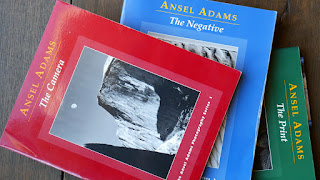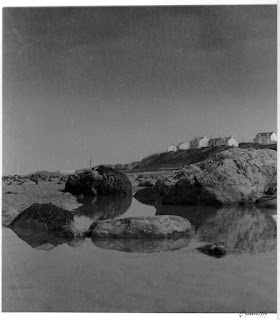On
the frontier of a new discovery in the darkroom A bit dramatic I
know but that is how I felt. All rubbish, I'm not the first to travel
this route. It is new ground for me and this time I have left the
research alone.
 |
| Fotospeed RCVC paper |
With
no preconceived ideas as to what was going to happen. I'm free to
experiment. The first and most noticeable problem is the colour of
the film base. Will I be able to set the grade of paper I want?
Before
the film got anywhere near the darkroom I found my old Ilford
multigrade filters and looked through them to see if the film base
had a close relation. It is lighter in colour to filter number four
in the set but will it interfere? I did try to duplicate the filter
grade on my colour enlarger the closest I could get was what I set
for grade three and that was darker.
 |
| Multigrade filters with XP2s film |
To
stop the speculation I contact printed all the film using white light
at two seconds with the lens fully open. These are some of the best
contact prints I have had, nicely toned and detailed. I was not
expecting that!
The
next thing to do was to scale it up to a print size in this case 8
x 10. I would do a segmented test print using white light and then set
to grade three. I chose Fotospeeds RCVC to do the test on. (A much
under rated paper ). I did the first print F8 for 4 sec's using white
light and set grade three at F8 for seventeen sec's.
 |
| HC 110 processed XP2s |
Here
is a thought, if film base was the colour of a particular filter
would all the negative on the film print at that grade? And would you
need graded filters any more? There's something to ponder while you
develop your prints. If you have any thoughts please share.
Where
was I hum! Yes the results of course. The difference between the
white light and grade 3 print? In short not a lot if you did not know
which was which you would be hard pressed to tell but there is a
subtle one it shows as an increase in the strength of tone and a
slight uplift in contrast.
 |
| XP2s contact prints exposed with 2 sec white light |
I
was expecting a difficult time in getting good results because of the
colour of the film base. This is partly because of what others had
suggested when they had a go at printing. In fact I have found so far
it very easy to print the XP2s negatives. I think if anything the
tint of the film base has enhanced the results.
 |
| This was the first graded print the white light print was slightly brighter |
If
we go back to when the film was exposed it was a very bright day with
lots of contrast and if this had been a normal black and white film
the contrast would have lead to a grade zero when being printed.
Instead the prints have been at my normal grade three. Thinking on
what others have said it leads me to believe that XP2s under
represents contrast levels which would explain the flat looking
prints when used normally. To counter this I would suggest using a
harder filter grade and or Kentmere RC to lift the contrast to a
better level.
 |
| Printed on Ilford multigrade FB paper |
Back
in the darkroom getting sharp focus was difficult. The grain seen in
the focus finder is very fine and the window of sharpness is very
small unlike traditional film emulsions. What I mean by this is when
turning the focus wheel on the enlarger the grain of the film
sharpens If you keep turning it stays sharp for a few degrees of turn
and then go's soft. With the XP2s it go's out of focus almost as soon
as it is sharp.
I
did try other grades of filter to see if they worked they did but
made the picture look muddy and very dark. Under normal circumstances
I would interpret this as the wrong grade being selected and or
over exposed.
In
answer to my question Will I be able to set the grade of paper I
want?
No!
I am of the impression that the colour of the film base plays a part
in the amount of contrast the paper displays. I have not really
forced the issue because the level of contrast I'm getting is to my
liking. But you may know differently in which case please share.
You maybe interested in this The first part of this post:









































